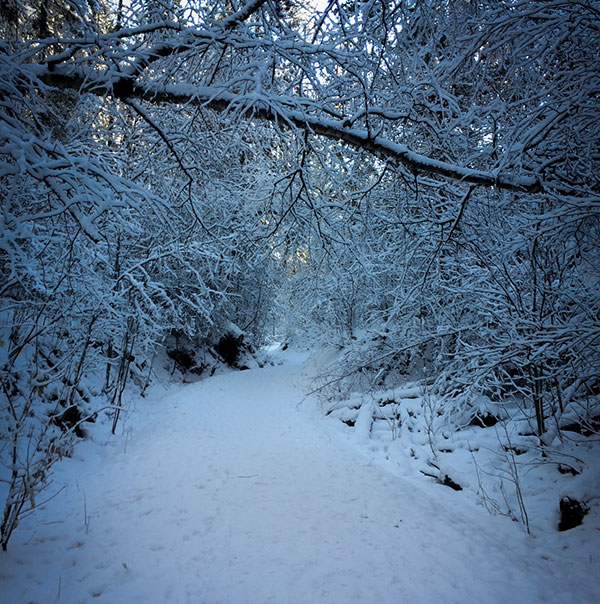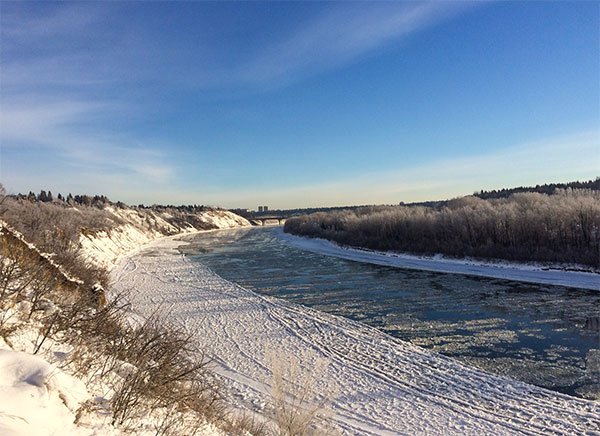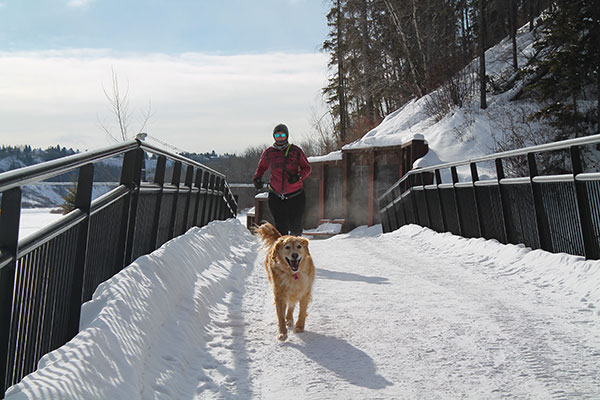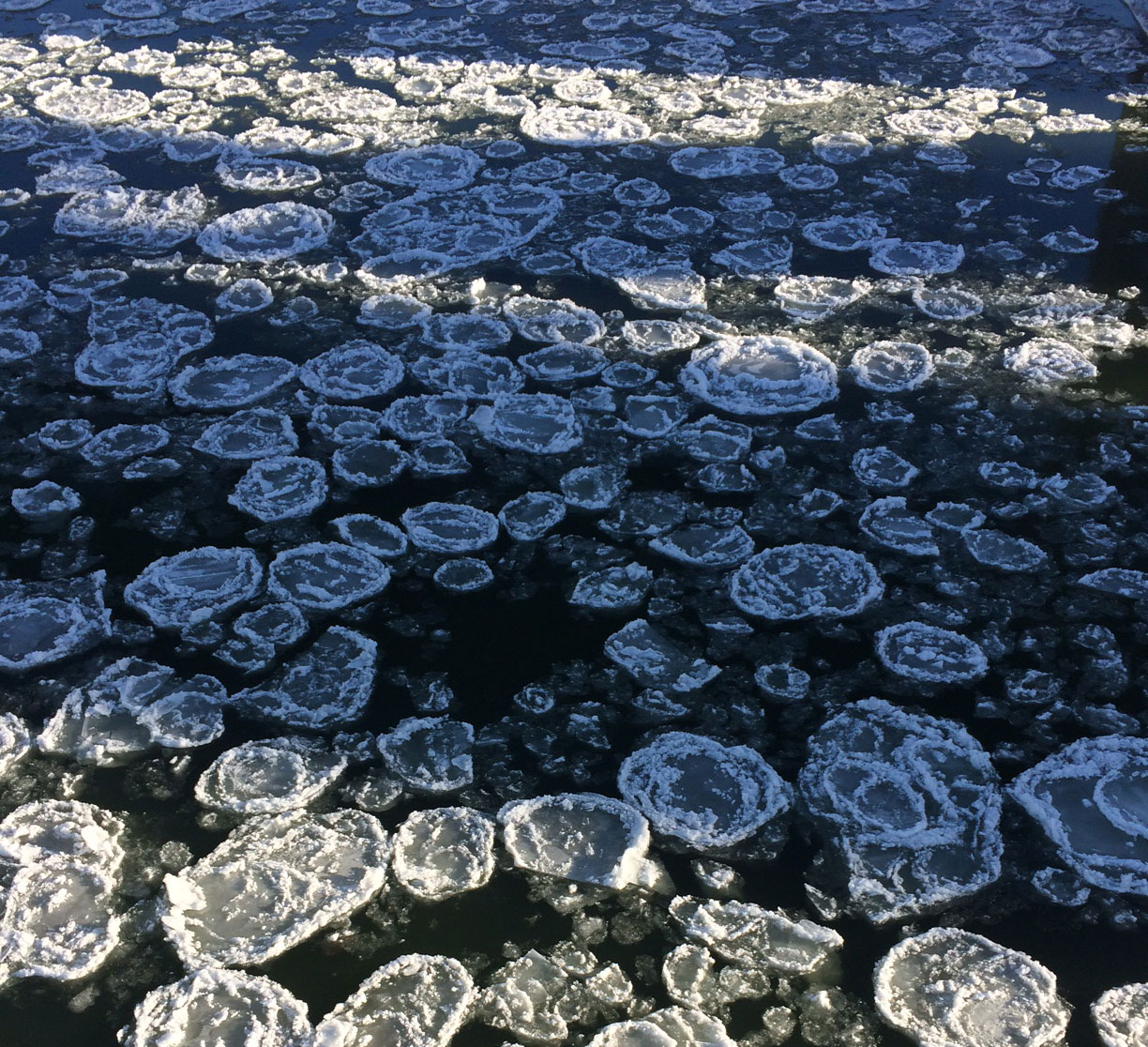Laura Barakeris invites us along one one of her winter runs in this guest blog.
The temperature is –23C. I take a deep breath to ready myself. I get out of my car, put my keys in my pocket, and I’m off. I run a few hundred metres down the sidewalk. A light breeze takes my breath away, but I know I will soon warm up. I cross the street and enter the trail that leads down to the river valley and all the sounds and distractions of the city retreat. The only sound is the crunch of my shoes on the trail. The wind disappears. If I stop, I can hear birds everywhere, but that is it—only nature sounds. The frosty trees hang over the trail and I feel like I’m running in Narnia. My breathing slows and deepens. When I run, my mind wanders, I fix problems, I write stories, and my perspective changes.

I run down the main trail, spotting a scarf looped over a tree branch. It’s not for me—someone’s probably lost it—but it’s a sign to look down and see the stomped path beside it. The path winds through the trees and is soon lost from sight, but I follow it around the forest, over logs and across bridges. Sometimes the path splits and I must decide which way to go, but it’s never a wrong choice. If it ends at a stump with birdseed on it or another street entrance, I can just turn around and take the other one.
People may complain about living in this cold northern city, but the river that splits our city in two, also puts a heart down the centre. Edmonton has over 160 km of multi-use trails and 150 km of single-track trails, and according to the River Valley Alliance, “The Capital Region River Valley Park covers 18,000 acres linking over 100 km through the North Saskatchewan River Valley. It is destined to become a world-class river front park that would be to the capital region what Stanley Park is to Vancouver or Central Park is to New York.” And to me, it already is. We live in a beautiful city. And those who disagree have not seen its heart.
The single-track trail loops around and back and I cross the main trail again. Before, I would just stick to the main trail, and it is equally beautiful and more accessible, but now that I’ve been shown these secret single-track trails, I look for them at every step. Down and up and around and over, looping, twisting through the trees, I wonder where this trail will take me. I climb and I slow and walk, my breathing deep, but I’m almost there, and finally I come out and see the whole beautiful icy river below me.

Things to consider:
- When running in winter, dress as if it is 10 degrees warmer. Running warms you up quickly and keeps you warm as long as you keep moving. But stay covered up to protect your skin from frostbite. The easiest way is to layer, adding or taking away depending on the temperature and wind chill.
- Start with a base layer that’s not cotton—synthetic (nylon, polyester, or polyester blend) or merino wool works well, then add another long sleeve or t-shirt as needed. Finish off with a windproof light jacket.
- On your legs, wear tights and another pant that blocks the wind.
- To keep your feet warm, wear wool socks or other sweat-wicking material.
- On your head a toque or ear warmers; and around your neck, a neck warmer or buff are needed.
- Your shoes should have as little mesh as possible in the winter so your toes don’t freeze.
- Your pace will be much slower on winter trails. Many runners walk up the hills and run the straight-aways and downhills. Think of it as intervals.
- Sometimes it’s slippery. Trail shoes are the best, but sometimes you need a little bit more grip. There are any number of grips you can buy for your shoes. Microspikes, ice grips, or cleats are a few of the different kinds of grips you can get.
- You still need to fuel properly. You may not sweat as much in the winter, but you still need water on long runs and because running in snow is more difficult than dirt trails, you may need to eat more often.
- Trails are more noticeable in the winter. There are no leaves on the trees and mountain bikers’ tracks and other runners’ prints are more visible in the snow.
- Winter is more bearable if you’re out in it. I used to hate winter, but getting out in the cold is the only way you’ll get used to it.
Still not sure? Check out one of the weekly group runs with the Edmonton Trail Runners, a grass-roots organization with over 2,000 members. Connect with this welcoming group on Facebook or Meetup.
Maps of Edmonton’s River Valley

